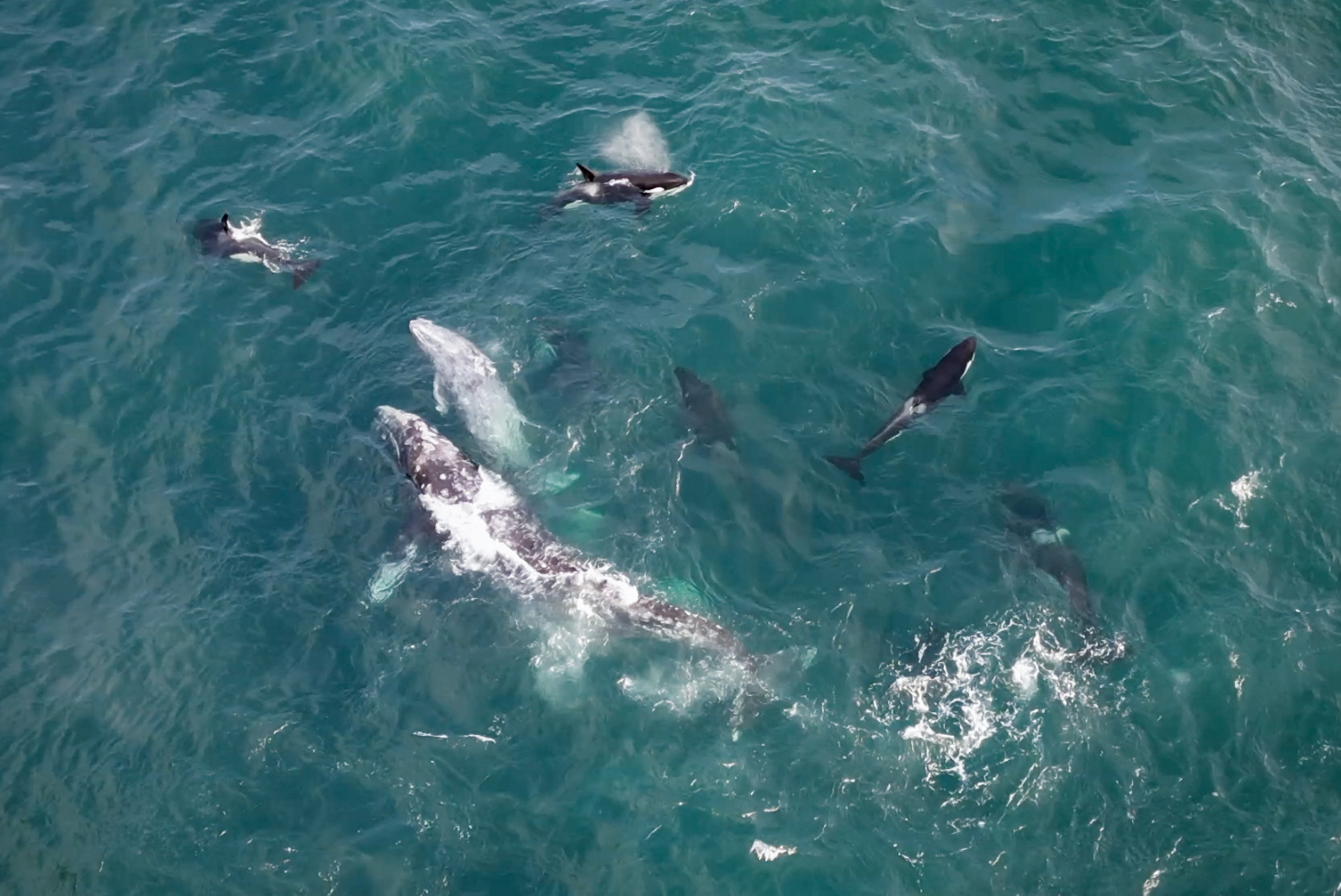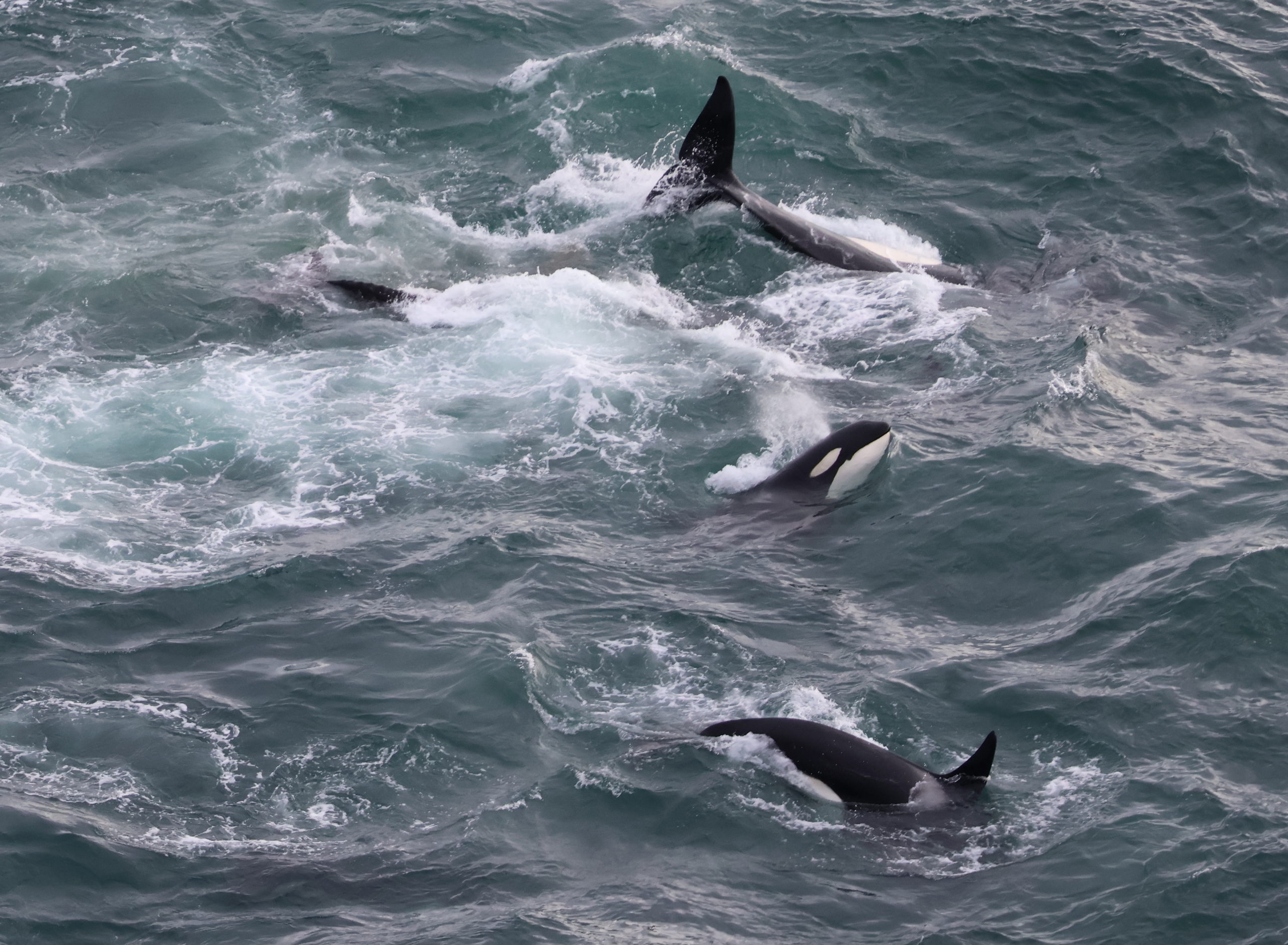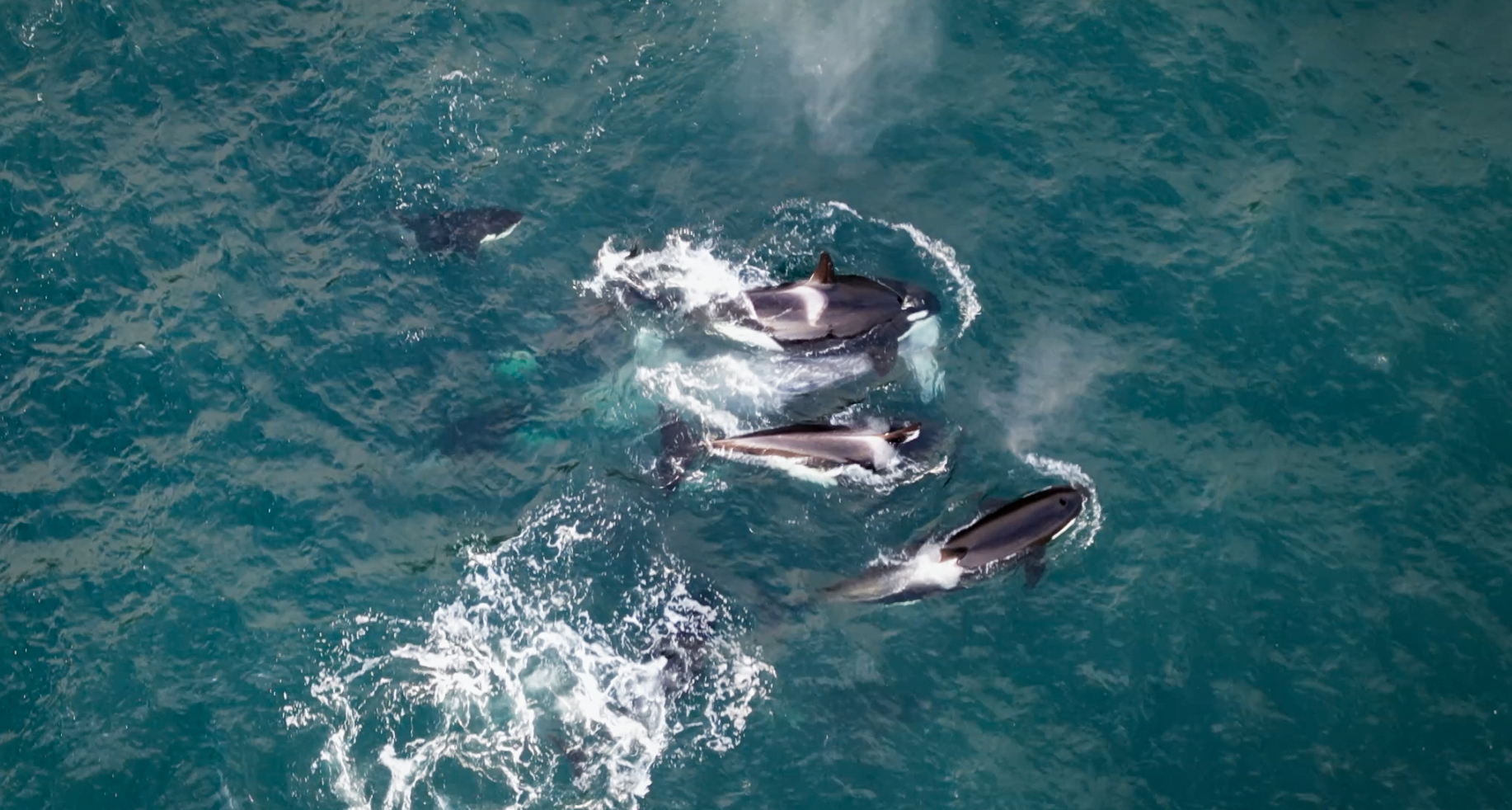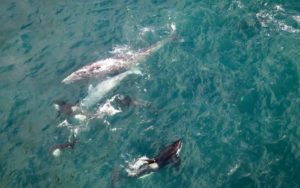
By DANA TIMS/YachatsNews
The lethal encounter between a pod of killer whales and two migrating gray whales off Oregon’s central coast this week is writing a new chapter in the scientific understanding of how two of the ocean’s largest species interact.
Monday evening’s attack by 11 killer whales was captured by countless still photographs and at least three small drones equipped with cameras. The three-hour incident ended with a gray whale calf dead. Its body washed ashore Thursday. It is not known if the mother survived.
And while efforts to identify the specific orcas involved is just getting underway, researchers say the incident is shedding new light on encounters that usually have to be deciphered long afterward.

“For us, we’re over the moon in proving some of the observations that gray whales washing up on Oregon beaches have showed,” said Josh McInnes, a University of British Columbia marine ecologist whose work focuses on killer whales on the West Coast. “This is fairly uncommon, to say the least.”
A sub-species of orcas known as transient killer whales has been sighted for weeks in Oregon’s coastal waters, often swimming as a group up area rivers to hunt young harbor seals. But the coordinated attack on an adult gray whale protecting her calf provided a rare chance to see up close a confrontation not often near enough to shore to be so widely photographed and documented.
Almost all of the 19 encounters between orcas and gray whales recorded in the database McInnes helps maintain have occurred in the waters off Monterey, Calif., he said. Monday afternoon’s predation in Boiler Bay, one mile north of Depoe Bay, is one of the only such actual encounters recorded in Oregon’s coastal waters.
“That definitely makes this event unusual,” McInnes said. “We’ve seen gray whale calf carcasses with killer whale bite marks wash up on Oregon’s beaches, but this is the first time we’ve seen an actual encounter. So in that sense, we’re already learning all sorts of new things from this.”
What he knows so far, based on a brief examination of some of the many high-resolution photographs submitted by onlookers, is that two different killer whale matrinlineal groups came together north of Lincoln City before heading south.
One group, known as the Coos Bay Killers, is headed by an orca known as T050, a female born in 1980 and her daughter born in 1999. The T050s – with combined four offspring — are common visitors to the Oregon coast, McInnes said, with the last report of the group off Depoe Bay on June 8, 2022. The second pod, the T068Bs, included a male born in 2008.
Both groups belong to a subspecies of killer whales known as the inner coast transient population.

Hunting in a pack
The way they were moving at such a fast rate indicates they were on a mission, McInnes said. “We’ve seen this before involving porpoises and sea lions, but this is likely the first time we have seen this behavior involving a hunt for gray whales.”
A Facebook page dedicated to killer whale sightings – Oregon Coast Killer Whale Monitoring Program — brimmed with accounts of those watching from nearby bluffs.
The descriptions, videos and photographs were intense enough that Holly Foster Robbins, writing later on the group’s Facebook page, said that she felt she was watching “the entire predation event in real time from my couch in Medford.”
First sightings of the pod put it at the north end of Lincoln City. The site of the actual attack was estimated to be near Boiler Bay just north of Depoe Bay.
The gray whales – a mother and her calf, believed to be from four to five months old — were traveling north as part of their annual spring migration from Mexico to Alaska, where they spend the summer. This time of year makes gray whale calves especially vulnerable, since they are still fairly weak and in the process of building up fat and muscle.
Transient killer whales are by far the most frequent sub-species of killer whales to frequent Oregon’s inner-coastal waters, mostly feeding on other mammals such as harbor seals, harbor porpoises and Steller sea lions. They are believed to number more than 400 and are increasing every year.
Occasionally seen in Oregon waters are so-called offshore killer whales, which feed primarily on sharks and other fish. They have also been known to hunt gray whale calves and can be found in the open ocean stretching from the eastern Aleutian Islands of Alaska to southern California.
The third sub-species of orcas in the Northwest Pacific are southern resident whales. Their range centers on the coastal waters off southern Vancouver Island and the inland waters of Washington’s Salish Sea. The southern residents, which feed primarily on salmon, are listed as among the world’s most endangered species of marine mammals. As of 2020 only 72 individuals remained.

Brutal ballet
Some onlookers, alerted to the killer whales’ movement Monday on the Facebook page, were quick to spot the two gray whales once the orcas were near Cape Foulweather. According to some reports, the adult stayed near the shoreline, taking care to position her body between the orcas and her calf.
What unfolded next proved excruciating to the many witnesses who recorded it all.
“It was the most intense thing I’ve ever seen,” said Pike Bremer of Newport, who watched the incident from Cape Foulweather. “It was really hard to watch, but fascinating at the same time. The calf was beautiful, but the orcas needed to eat. It all just left me without words.”
The mother repeatedly tried to help the calf get to the surface to breathe, she said, even as the orcas appeared to ram the calf and keep it submerged to drown it.
The actions of the killer whales, she said, almost seemed to be choreographed.
“It was like a ballet,” Bremer said. “It was beautiful and breathtaking to watch, even as it was just an awful thing to witness.”

Jaklyn Larsen, a professional photographer based in Florence, decided to drive north as soon as she heard a group of killer whales was attacking gray whales. By the time she arrived at Devil’s Punchbowl State Natural Area between Newport and Depoe Bay, about two dozen other people were watching an attack that was well underway, she said.
“I don’t know if everyone appreciated exactly what was happening,” Larsen said. “But with my drone, I could see very clearly that the killer whales were coordinating their attacks to try to separate mother from the calf.”
She added, “From top-down views, you could see they were definitely doing some damage. It was brutal.”
Seemingly endless flashes of dorsal fins, punctuated by great sprays of water, took their toll. Eventually, Larsen and those around her realized that the calf was no longer trying to resurface to breathe.
“Even then the mother kept trying to lift her baby to the surface,” Larsen said. “She kept trying to get some reaction from her calf, and it was just heartbreaking.”
The orcas’ orchestrated activity included another technique, as well, she said. With her drone, she was able to see that the killer whales also hovered over the mother in an apparent effort to keep her submerged, and thus deprived for air for as long as possible as she tried to defend her calf.
Larsen later posted a long video and her description of the event — including a warning of “brutal footage” — and her emotional reaction to it on YouTube.
Feeding behaviors
It’s long been thought that killer whales will eat just the tongue and perhaps lower jaw of gray whales they end up killing, McInnes said. That notion, too, could come in for some revision based on the Boiler Bay attack.
“The theory has been that they go just for those easy-to-reach delicacies,” he said. “But photographs we have seen so far show bite marks on tissue throughout the carcass.”
In addition, orcas were spotted the following day in Boiler Bay, apparently still feeding on the calf’s carcass. It may be that feeding behaviors vary from group to group, McInnes said.
“This is just one more thing that we are still trying to figure out,” he added.
Citizens’ science
McInnes just happened to be driving to a conference in Monterey when the attack was taking place. The topic of the conference? Orca encounters with gray whales.
Efforts to better understand such attacks in Oregon water are being aided tremendously, he said, by the rapidly growing army of dedicated orca-watchers here.
“We are hearing that a large number of people now are making this a regular part of their daily routine,” McInnes said. “Folks will just grab their binoculars and head to the beach to see if any killer whales are out there.”
The Facebook page dedicated to documented killer whale sightings has now grown to 9,500 members. Another 350, apparently inspired by this week’s attack alone, are now waiting to be admitted to the page by the site’s administrator, he said.
McInnes said he eventually hopes to publish a paper based on these Facebook posts alone.
“Washington and California have their own killer whale Facebook sites, but this one is for Oregon posts alone,” he said. “It’s a very exciting project, and encounters like this one make for a lot of very good scientific evidence.”
- Dana Tims is an Oregon freelance writer who contributes regularly to YachatsNews.com. He can be reached at DanaTims24@gmail.com



Thanks for another excellent article on this subject. The calf’s carcass washed up on north end of Beverly Beach (just south of Otter Rock community). There’s no adult gray whale carcass near the calf or that I’ve heard of in the mid-coast. Scientists (likely including those from OSU’s Marine Mammal Institute in Newport) have examined the calf’s carcass and taken tissue samples for various analyses. Signs on beach ask people to keep distance and not touch.
I think your article did err in statements about Boiler Bay. Killer whales were first seen Monday moving south from the north end of Lincoln City a couple of hours before the attack, and were seen going past Depoe Bay about an hour before the attack (so they passed Boiler Bay before passing Depoe Bay). But I’ve seen no report of gray whales along the route until the attack off Cape Foulweather. Not at all sure gray whales were being followed or chased south to Cape Foulweather, or just encountered near or at Cape Foulweather around 5 or 5:30 PM as the grays were likely migrating north as they do this time of year.
Could the killer whales somehow detect the grays were there from many miles away? I’ve never heard or read of any such detection ability by them, though another marine mammal (Harbor seal) has been shown to detect beeps from certain types of research tags on salmon from up to about a mile away.